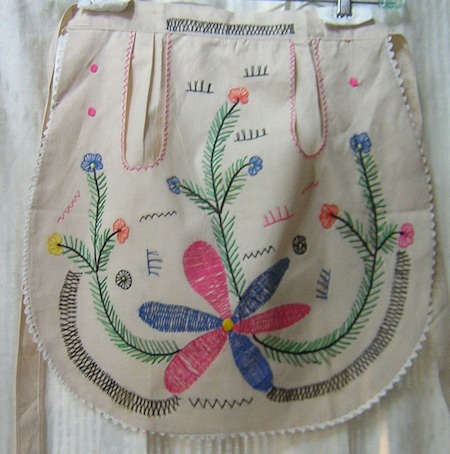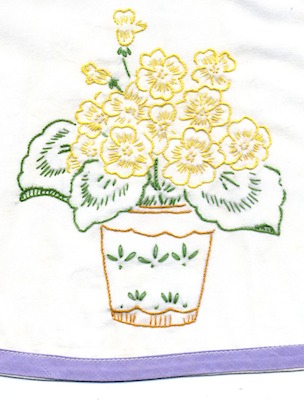- Home
- Vintage Embroidery
Photos of vintage embroidery
Imagine holding a piece of history in your hands, stitched with love by generations past.
For centuries, embroidery has woven together cultures and traditions, telling stories of status, heritage, and creativity. In particular, vintage embroidery spanning from the late 19th century to the mid-20th century.
These exquisite pieces, often adorning treasured clothing, linens, or keepsakes, are more than just beautiful decorations – they're tangible ties to the past, crafted with techniques carefully passed down through families.
In the mid 20th century, embroidery kits and patterns became widely available in stores, allowing more women to take up the craft at home.
Techniques like freehand embroidery, which Averi's mother, Julie Mola, favoured, allowed for creative expression and was especially popular in home-made clothing and linens, such as aprons, pillowcases, and tablecloths.
Averi kindly sent me photos of her mum's pieces to share with you.
The Embroidered Apron

Aprons have long been practical garments, but during the mid-20th century, as women spent more time in the kitchen or attending to household chores, they provided an opportunity to express their creativity.
They were often embellished with hand embroidery to add a personal touch to these everyday items.
This was especially common in the 1930s-1950s when homemakers took pride in creating beautiful yet functional garments.
Julie's apron, above and below, is made even more functional by the addition of slit pockets to keep essentials easy to access.

The large flower, in pink and blue embroidery floss, appears to have used two rows of herringbone stitch for each petal.
This stitch is used in many vintage embroidery patterns, both for its decorative appeal and durability. It creates a criss-crossed look, perfect for large areas, and its overlapping nature provides extra strength, preventing long threads from snagging.
The double row of herringbone stitch used on the apron not only adds texture but also serves a practical purpose by shortening the length of the stitches used to fill the petals.
Julie embroidered a similar apron in a different colour scheme...

...and a slightly different pattern. Again, she makes use of herringbone stitch, this time for the border.

Straight stitches in two shades of green depict fir branches.
Another stitch used in a variety of ways on these two examples is buttonhole or blanket stitch.
Another common stitch in vintage embroidery, it was often used for edging or decorative details like the circular motifs on Julie's apron. Its flexibility allows for creating tight or loose decorative borders.
It is possible that the red leaves are appliquéd in place.
Embroidered Pillowcases
Embroidered pillowcases became popular during the Victorian era and continued to be a household staple well into the 20th century.
They were often included in a bride’s trousseau, symbolising the care and dedication she would bring to her new home. Such pieces were made to be decorative, yet practical, and the use of hand-embroidered designs like flowers and animals added a personal touch to the bedding.
The example below incorporates delicate embroidered ferns, stitched in green, yellow and blue, along with blue flower motifs. Sadly I can't see clearly which stitch Julie used for these in the photograph. She finished off the pillowcase with a crocheted edging.

Julie’s next hand-embroidered pillowcase is reminiscent of the popular Redwork embroidery style from the late 19th and early 20th centuries.
Redwork often used simple designs, typically outlined in red thread, and was widely used for home linens and children's items.
The little flowers are worked in lazy daisy stitch. This pillowcase may have been worked over a transferred image, with the delicate colouring on the bunny already printed on the fabric.

The next piece to share with you was also on a pillowcase. This is just a detail, showing a potted plant.

Basket of Flowers Tablecloth
Embroidered tablecloths became fashionable in the early 20th century, particularly in the 1920s-1950s. Embroidery added a decorative flourish to otherwise plain linens, as a way to show hospitality.
Tablecloths, such as Julie’s below, were often used at family gatherings and celebrations. The intricate work demonstrated the homemaker’s attention to detail and artistic skill.
Many vintage embroidered tablecloths featured natural motifs, such as flowers and plants, symbolising abundance and prosperity.
Stem Stitch: Used for the basket outline, the stem stitch provides a durable yet elegant finish. This technique is perfect for creating a strong yet decorative line, especially when combined with other more delicate stitches, like lazy daisy, for the leaves.
Lazy Daisy Stitch: The use of lazy daisy stitch in the flowers and leaves gives the piece a light and airy feel, characteristic of many vintage floral designs. Also know as detached chain stitches, they were often used in vintage embroidery to give movement and texture, making the overall design feel more dynamic.

Embroidery has always been more than just decorative; it connects us to our past and preserves the artistry and creativity of those who came before us.
Each stitch tells a story—whether it’s passed down through generations, or newly crafted with inspiration from the past. We are honored to share Julie Mola’s vintage embroidery and hope it inspires you to explore your own creativity.
If you have any examples you would like to share be sure to drop me an e-mail on the Contact Carol page and maybe I can feature it for you.
What did you think of this page?
Did it give you all you needed or did anything else spring to mind? If there was something missing give me a shout – or let me know if this page proved helpful (do let me know which page you are commenting on).
Would you like a direct reply? Just pop your email address below, and I'll be in touch.
Stay connected between projects
If you’d like occasional updates from my embroidery room, including new patterns, gentle tips, and little things I think you might enjoy, you’re warmly invited to join the Stitchin’ Times newsletter.
No pressure. Just a friendly note now and then to keep you inspired.













